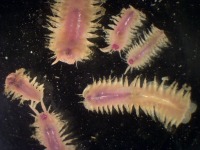
(Photo: Huntsman Marine Science Centre)
Moore's Hartmania
Hartmania moorei
A worm with up to 40 segments. Body is uniform in width, tapering at the anterior and posterior end. It is pale to light brown in colour and has four eyes. Adults can be up to 15 millimetres in length and 5.2 millimetres in width.
Authority
Pettibone, 1955
Classification Details
Phylum: Annelida (worms); Class: Polychaeta (bristle worms)
Habitat
Found in the northwest Atlantic, from the Arctic to south of Cape Cod. The larval form is a zooplankton, found throughout the water column. The adult is a benthic organism, found in burrows in mud, sand, silt, or clay.
Diet
A predator, with two pairs of interlocking jaws. The specifics of their eating habits are not known to science.
Reproduction
Females found filled with eggs in November. The specifics of their reproduction patterns are not known to science.
Fun Facts
They live commensally (species association where one species benefits but the other neither benefits or is harmed) in the burrows made by other species.
References
Pettibone MH (1963) Marine Polychaete Worms of the New England Region. Vol 1. Washington: Smithsonian Institution. Pettibone MH (1995) New species of polychaete worms of the family Polynoidae from the east coast of North America. Journal of the Washington Academy of Sciences 45, 118–126. Read G and Fauchald K (2020) World Polychaeta database. Hartmania moorei Pettibone, 1955. Accessed through: World Register of Marine Species at: http://www.marinespecies.org/aphia.php?p=taxdetails&id=157436 Accessed online 20 January 2020. Van Guelpen L, Pohle G, Vanden Berghe E and Costello MJ (2005) Marine Species Registers for the North Atlantic Ocean. World Wide Web electronic publication. http://www.vliz.be/vmdcdata/narms/

